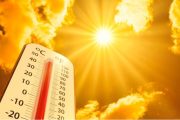
Data from the U.S. Climate Reference Network (USCRN) developed by the National Oceanic and Atmospheric Administration (NOAA) shows that the United States has undergone a cooling trend over the last decade.
This data contradicts a recently released report from a group of authors affiliated with NOAA and National Centers for Environmental Information (NCEI) that attempted to refute previous studies indicating that there had been a hiatus in global warming.
Anthony Watts, a former broadcast meteorologist and publisher of the science blog Watts Up With That?, compiled NOAA/USCRN data to use the agency’s own statistics to refute the recent report (“Possible artifacts of data biases in the recent global surface warming hiatus”) by NOAA researchers claiming there has been no 15-year “hiatus” in global warming.
“Newly corrected and updated global surface temperature data from NOAA’s [National Centers for Environmental Information] do not support the notion of a global warming ‘hiatus’,” wrote the NOAA scientists in their report.
In that report, NOAA’s team of authors disputed the results of the Intergovernmental Panel on Climate Change (IPCC) Fifth Assessment Report that had concluded that the global surface temperature “has shown a much smaller increasing linear trend over the past 15 years [1998-2012] than over the past 30 to 60 years.”
In his June 14 article, Watts referred to that same NOAA/NCEI report, authored by a team led by Thomas R. Karl (the director of the NOAA’s National Climatic Data Center) that we also mentioned in a June 5 article. As we noted:
The [NOAA] authors presented what they claim is “an updated global surface temperature analysis that reveals that global trends are higher than reported by the IPCC, especially in recent decades, and that the central estimate for the rate of warming during the first 15 years of the 21st century is at least as great as the last half of the 20th century.”
Furthermore, assert the authors: “These results do not support the notion of a ‘slowdown’ in the increase of global surface temperature.”
In an earlier blog on June 4, Watts coauthored a piece with Bob Tisdale (who has his own blog, “Climate Observations”) that noted that to “manufacture warming during the hiatus, NOAA adjusted the pre-hiatus data downward.”
“If we subtract the [old] data from the [new] data … we can see that that is exactly what NOAA did.”
“It’s the same story all over again; the adjustments go towards cooling the past and thus increasing the slope of temperature rise,” Tisdale and Watts added. “Their intent and methods are so obvious they’re laughable.”
For his June 14 article, Watts plotted the USCRN data on a graph and concluded: “Clearly, a ‘pause’ or ‘hiatus’ exists in this most pristine climate data. In fact, a very slight cooling trend appears.”
The assertions made in the NOAA report were also called into question by Dr. Judith Curry, former chair of the School of Earth and Atmospheric Sciences at the Georgia Institute of Technology, who wrote:
My bottom line assessment[ of the NOAA report] is this. I think that uncertainties in global surface temperature anomalies is substantially understated. The surface temperature data sets that I have confidence in are the UK group and also Berkeley Earth. This short paper in Science is not adequate to explain and explore the very large changes that have been made to the NOAA data set. The global surface temperature datasets are clearly a moving target. So while I’m sure this latest analysis from NOAA will be regarded as politically useful for the Obama administration, I don’t regard it as a particularly useful contribution to our scientific understanding of what is going on.
What’s Up With That? published another article on June 4 that was critical of the NOAA report denying that there has been a hiatus on global warming. It was coauthored by three respected experts in the field of climate science: Patrick J. Michaels (a senior fellow in environmental studies at the Cato Institute and a former research professor of environmental sciences at the University of Virginia); Richard S. Lindzen (an atmospheric physicist, known for his work in the dynamics of the middle atmosphere, atmospheric tides, and ozone photochemistry); and Paul C. Knappenberger (the assistant director of the Center for the Study of Science at the Cato Institute, who spent 10 years with the Virginia State Climatology Office and 15 years as the research coordinator for New Hope Environmental Services, Inc.)
The trio of climate experts wrote, in part:
A new paper published today by Science, from Thomas Karl and several co-authors … that removes the “hiatus” in global warming prompts many serious scientific questions.
The main claim … by the authors that they have uncovered a significant recent warming trend is dubious. The significance level they report on their findings (.10) is hardly normative, and the use of it should prompt members of the scientific community to question the reasoning behind the use of such a lax standard.
In addition, the authors’ treatment of buoy sea-surface temperature (SST) data was guaranteed to create a warming trend. The data were adjusted upward by 0.12°C to make them “homogeneous” with the longer-running temperature records taken from engine intake channels in marine vessels.
It is obviously impossible for the untrained layman to determine which theories postulated by scientists on either side of the global-warming debate are accurate and which are not. However, one thing is certain: There is enough disagreement among credible scientists to cast serious doubt on the assertion that we are in a period of catastrophic “global warming,” and furthermore, that such warming (if it exists at all) is caused by anthropogenic (human) carbon dioxide emissions.
Given this scientific uncertainty, it is obviously presumptuous for our government to not only take a position on climate change, but to implement government policies based solely on one side of the debate. Statements posted on the White House website have already taken a stand, blaming human activity for global warming:
We’re still contributing to the problem.
Carbon Pollution is the Biggest Drive of Climate Change.
Of course, if “we” are responsible for the problem, the solution is to restrict “us” from activities that create carbon pollution, such as imposing strict environmental regulations on power plants and “cutting energy waste, in homes, businesses, and factories.”
“Global warming” is the bureaucrat’s dream issue. It could provide an overzealous government with all the authority it needs to regulate every aspect of human activity.
It is time for uncensored debate on the subject and common sense to prevail.
Related articles:
Climate Expert Lord Monckton: Global Warming Ceased Over 18 Years Ago
NASA’s Own Data Discredits Its Predictions of Antarctic Doom
Climate Realists Challenge UN at Vatican Global Warming Conference
Scientists’ Message to Pope: Be Skeptical of Climate Change Alarm
Congress Warns UN That Obama “Climate” Pledges Not Binding
Documentary Outguns the Opposition in the Global-warming War
Computer Models vs. Climate Reality
Confab of Climate Experts to Challenge Global Warming “Consensus”
Whatever Happened to Global Warming?
“Not Evil Just Wrong”: Dissecting Environmental Extremism
Climate Change: Global Warming May be Beneficial
Scientists Debunk Climate Models
Environmentalists Lose More Credibility With Global-warming Claims
Documentary Outguns the Opposition in the Global-warming War
Greenpeace Founding Member: Climate Alarmism “Preposterous,” CO2 Emissions Saving Lives
Inhofe Throws Snowball in Senate to Refute Global Warming
N.Y. Times, Greenpeace Smear Warming Skeptic Dr. Willie Soon



